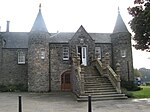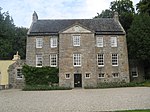Old Meldrum railway station
1856 establishments in Scotland1966 disestablishments in ScotlandDisused railway stations in AberdeenshireFormer Great North of Scotland Railway stationsPages with no open date in Infobox station ... and 3 more
Railway stations in Great Britain closed in 1931Railway stations in Great Britain opened in 1856Use British English from October 2022

Old Meldrum railway station was a railway station in Old Meldrum, Aberdeenshire. It was the terminus of the Inverury and Old Meldrum Junction Railway.
Excerpt from the Wikipedia article Old Meldrum railway station (License: CC BY-SA 3.0, Authors, Images).Old Meldrum railway station
Westend Gardens,
Geographical coordinates (GPS) Address External links Nearby Places Show on map
Geographical coordinates (GPS)
| Latitude | Longitude |
|---|---|
| N 57.334 ° | E -2.328 ° |
Address
Old Meldrum
Westend Gardens
AB51 0JG
Scotland, United Kingdom
Open on Google Maps






